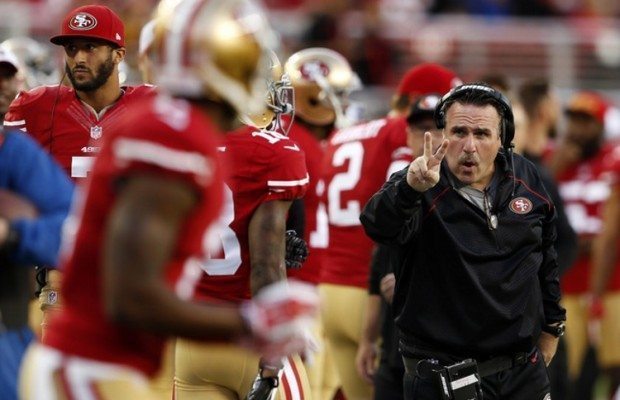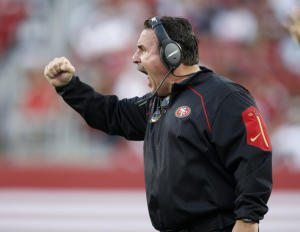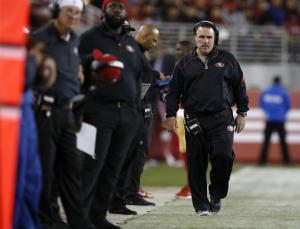What 49ers head coach Jim Tomsula learned on his European vacation

San Francisco 49ers head coach Jim Tomsula signals to to make a two-point conversion after Bruce Ellington (10) scored a touchdown against the San Diego Chargers in the first quarter of a NFL preseason game at Levi’s Stadium in Santa Clara, Calif., on Thursday, Sept. 3, 2015. (Ray Chavez/Bay Area News Group) ( RAY CHAVEZ )
Original story published in the San Jose Mercury News, September 14, 2015.
Whatever challenges await Jim Tomsula in his first year as an NFL head coach, it seems unlikely that his 49ers will mistakenly board a bus heading for a wedding in Duesseldorf, Germany.
There will be no end zones made of plywood, no games disrupted by Berlin Bike Week, no trouble reaching officials in Barcelona because it’s siesta time.
But if any of those things happen, consider Tomsula ready.
He faced all those hurdles while in NFL Europe, the only place he has ever carried the title of head coach. Tomsula guided the Rhein Fire to a 6-4 finish in 2006 and before that spent eight years as an assistant coach in places such as Scotland, London and Berlin.

San Francisco 49ers head coach Jim Tomsula yells at his team during their game against the Dallas Cowboys in the fourth quarter of their NFL preseason game at Levi’s Stadium in Santa Clara, Calif., on Sunday, Aug. 23, 2015. (Nhat V. Meyer/Bay Area News Group)
Now, nearly a decade later, Tomsula has a top job again, this time on domestic soil. For a snapshot of what the 49ers can expect, we looked back at his postcards from Europe and tracked down ex-players from the Fire.
In general, the reviews were good. Players said Tomsula proved adept at handling everything from the passing game to the passport game. His fans include Drew Henson, the only starting quarterback Tomsula has ever had.
“Just seeing some of the quotes of the current 49ers guys, they speak the same as I feel about him: He’s genuine,” Henson, the former Michigan standout, said in a phone interview. “I think he takes the big-picture stuff into mind, and understands the different challenges that guys have.”
Ron Whitaker, a cornerback who led NFL Europe in interceptions while under Tomsula, called him “the best coach I ever had.” Why that matters: Whitaker played under the likes of Jon Gruden and Mike Tomlin in the NFL and Frank Beamer at Virginia Tech.
“I told my fiancee the minute he got hired, ‘That’s the best move the San Francisco 49ers could make,’ ” Whitaker said. “They’re getting a hell of a coach. Period, point blank. And I’ve heard the rumblings. I hear social media, with people saying, ‘Oh, this guy is only a defensive line coach.’ Give it time. Trust me, it won’t be wasted time.”
Travis Dorsch, a kicker and punter for Rhein, said:
“Of all the people that I met, Jim was maybe the most passionate and the most caring that I ever played for. He was 100 percent invested in his guys, and that was kind of a great feeling for an athlete.”
Such dreamy-eyed memories sound as if they come from someone’s college year abroad, which isn’t far from the truth. In NFL Europe, a developmental league that existed in various forms from 1991 to 2007, players and staff stayed in a single hotel, dorm-style, for about 12 weeks.
Teams made do on tight budgets and in cramped quarters — and often bonded in unexpected ways. (Henson said he keeps in better touch with his Fire teammates than those from just about any other professional stop.) Tomsula was part head coach, part travel guide, making sure his players were fed, housed and pointed down the right autobahn.
“When you’re in Europe, you’re loading the plane. You’re flying commercial,” Tomsula said from the conspicuously more plush accommodations of his 49ers office. “The great thing is, I’ve done equipment. I’ve done food. I’ve done beverage. I’ve done hotel rooms. I’ve checked bills. We’ve worked with the interns. We’ve worked with the PR department. We’ve done every single facet of the organization.”
Tomsula said that being in charge of even the smallest details was a formative experience. His trial by Fire taught him to appreciate the minutiae it takes to keep an organization afloat (and perhaps explains his shoutout to “Joan in Payroll” on the day he was hired by the 49ers).
Some people have their “aha!” moment when the light goes on. Tomsula had his when it went off.
“You know those light bulbs for a video machine?” he said. “Those are, like, $600 apiece. And when you’re in the Europe league, on a tight budget, you have to order it through New York, then it has to be shipped back to you, and you only have a 10-week season.
“So if that light goes out, you’re probably not getting a new light bulb. And I still, to this day, walk around here checking to make sure the overhead projectors are off. That’s from NFL Europe. And that isn’t a bad thing.”
Solving other problems, however, wasn’t as easy as flipping a switch.
There was that time in Duesseldorf when Tomsula walked out of the team hotel before a game to see 12 buses lined up to take players to the stadium. Tomsula, an assistant coach for the Scottish Claymores at the time, thought it was odd — they usually only had four buses. It got even odder when the bus driver started driving the opposite direction of the stadium.
“And none of us spoke German,” Tomsula said, still laughing. “We were across the river and we were looking down, and there’s the old Düsseldorf stadium. We were on the buses for a wedding or a banquet, whatever they were going to.
San Francisco 49ers head coach Jim Tomsula walks on the sidelines during their game against the San Diego Chargers in the third quarter of their NFL preseason game at Levi’s Stadium in Santa Clara, Calif., on Thursday, Sept. 3, 2015. (Nhat V. Meyer/Bay Area News Group)
“We had everybody trying to talk to the guy, but we can’t understand him. I don’t know how it finally got settled, but we eventually got him to turn around and come back.”
There was that time in Amsterdam when the Claymores played at the Olympic Stadium, which was built for the 1928 Summer Games. Upon arriving for the football game, coaches noticed that one end zone was located over a steeplechase pit. The groundskeepers had simply covered the pit with plywood before sprinkling grass on top. (And you thought the turf at Levi’s Stadium was bad.)
With no time for a suitable repair — the game was being broadcast live back in the United States — coaches came up with a quick fix. Every time there was a change of possession, a TV timeout gave the offense enough time to flip toward the usable part of the field. “Both teams went to the same way the entire game,” Tomsula said. “And as far as I know, the viewers back home never noticed.”
There was that time in Pamplona, Spain, where the Claymores played a preseason scrimmage against the Barcelona Dragons.
“Gorgeous place, the whole deal, but we go out to the stadium and the field is, like, (72) yards wide. It’s soccer-width,” Tomsula said. (An NFL field is 53 yards wide). “But they left all of the hashes and number markers the same, so you’re trying to play a Cover 2 and all of your landmarks all over the field were totally off.”
There was that time in Berlin when the Frankfurt Galaxy was supposed to arrive for a game against the Thunder. But the Galaxy buses got caught up in an epic cycling event that clogged traffic in the city.
“They got there about seven minutes before kickoff, and it was nuts,” Tomsula said. “We won the game pretty good, though. I remember that.”
Tomsula said that most of the hiccups in Europe came early in the league’s existence, not long after the NFL launched the venture as a way of identifying and developing overlooked or untapped talent. By the time Tomsula was named a head coach — at 38, he was the youngest in the league — NFL Europe was a smoother operation with games drawing up to 50,000 fans some days.
In a questionnaire he filled out for the NFL before this season, Tomsula was asked to list “the loudest crowd of his career, home or away.” The man who once stood on the sidelines in Seattle for an NFC championship game provided a surprising response.
“Amsterdam Arena where the Amsterdam Admirals of NFL Europa played,” Tomsula answered. “There couldn’t have been more than 10,000 people there, but if I was standing next to you and screamed, you might not have been able to hear me. I don’t know what they had going on there.”
In all, Tomsula coached for nine seasons overseas and took part in three World Bowl championships. His lone title came as the defensive line coach for the 2004 Berlin Thunder.
Along the way, doing every job the league had to offer — from monitoring the medical staff to ordering new light bulbs — taught Tomsula a respect for the inner workings of an organization. As a result he is more, ahem, diplomatic than his predecessor. While Jim Harbaugh had a famously uneasy relationship with general manager Trent Baalke and others within the 49ers complex, Tomsula’s easygoing approach is part of why he was hired in the first place.
Consider Tomsula’s take on the GM job after doing it himself with the Rhein Fire:
“You really understand how hard that is and the strain and the stress that’s on that job. You also understand that it’s not an exact science. So the way you perceive the personnel department is different.”
His ex-players with the Fire said that Tomsula took a similarly understanding approach to the field, and earned their loyalty as a result. Henson said Tomsula created an atmosphere in practice where risk-taking was encouraged. Tomsula told his quarterbacks, Henson and Timmy Chang, that the practice field was the best place to learn the difference between a good gamble and a bad one.
“You learn more from making a mistake on a certain play than you do when you have a clean look every time,” said Henson, who had been allocated to Europe by the Dallas Cowboys. “As a quarterback, it was great just having the freedom to try to make plays in practice and not worry.”
The 2006 Rhein Fire leaves the only traceable evidence of how Tomsula, a lifelong defensive coach, might orchestrate the 49ers offense. Henson said the team struck a nice running/passing balance while operating mostly out of pro-style, three-receiver sets. The Fire operated out of a zone running scheme, relied heavily on the play-action pass, and “were pretty aggressive, I’d say,” Henson said.
Then again, there were times when injuries dictated the game plan. Players — like light bulbs — sometimes malfunctioned.
“You really have a great appreciation for medical staff, because if a guy is injured, and he’s done, your nearest replacement is 6,000 miles away,” Tomsula said. “And if you do get them, now you’ve got to get work permits and government paperwork for them to be able to work. That could be anywhere from a week to two weeks.”
Whitaker, the cornerback, said Tomsula’s ability to roll with the punches included his acceptance of different personalities. Whitaker, the nephew of boxer Pernell “Sweet Pea” Whitaker, said he loved to talk trash to opposing receivers. While other coaches told him to cut it out, Tomsula struck a deal.
“He never once tried to handcuff that,” Whitaker said. “He was one of those guys who said, ‘As long as you keep it in between the lines and we don’t see any yellow laundry, I’m OK with whatever you do. Just make sure it doesn’t take away from the team and that you’re playing at the highest level.’ “
Too loose? No chance, Whitaker said. He said other players tried to trash talk, too, but crossed Tomsula’s line. “You have to respect your opponent,” Whitaker said. “So he came to me and asked me to go to other players on our team to make sure they had an understanding of that.”
Dorsch, the kicker/punter, said Tomsula won over the locker room with an open door — and an open ear. The coach made a point of reaching out to everyone from the star players to special teamers.
“One of the things I respected most is that it wasn’t a ‘master and subordinate’ relationship. It was very much that he looked at us as integral pieces of the team, and he came to us with questions, thoughts and concerns,” said Dorsch, now an assistant professor at Utah State University. “It was almost as if he treated everybody on the team as a team captain.”
Tomsula, meanwhile, remains forever grateful to Lionel Taylor, the former Denver Broncos star receiver who later became a distinguished coach. It was Taylor who first called Tomsula out of the blue to ask if the defensive line coach at Division II Catawba College (North Carolina) wanted to come fill the same role for the England Monarchs in 1998.
One vivid Euro memory is probably better if lost in translation. Whitaker spent a game against Berlin miked up — meaning those watching from home in Europe could pick up every word from their living rooms.
Whitaker wound up with an interception that day. And Tomsula got so fired up he forgot about the microphone.
“I’m running over to the sidelines and he says, ‘Hey, they (expletive) up, didn’t they? I tried to tell the other coach not to throw toward you because they’re going to (expletive) up!’
“That’s what we thought was so funny when we saw it later. We told the guys from Germany, ‘Hey, in America, this stuff is bleeped.’
“But it was also one of those things where people were able to look at Tomsula and say, ‘That guy loves his players.’ He’s tough as nails, but don’t get that wrong. He’s a big teddy bear.”
